Discovering Surfboard Building Classes for Enthusiasts
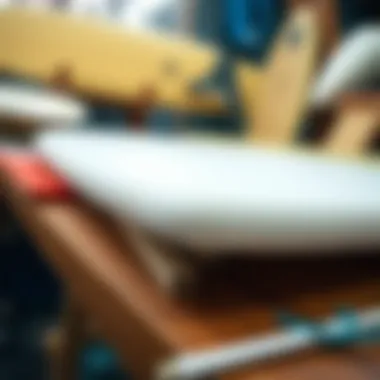
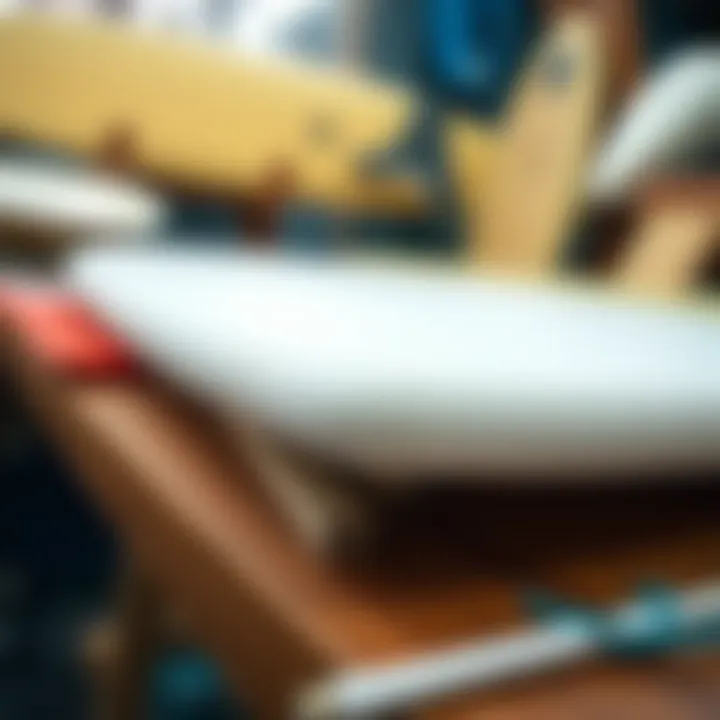
Intro
When one thinks of surfing, the image that usually comes to mind is of waves crashing against the shore or surfers gracefully gliding across the water. Yet, the journey to mastering this exhilarating sport starts far from the beach, in the meticulous world of surfboard crafting. Surfboard building classes are not merely about shaping a piece of foam; they embody a connection to the ocean, emphasizing artistry, craftsmanship, and personal expression. In this guide, we will traverse the nuances of these classes and uncover the skills and materials that elevate your surfing experience.
Through pressing into the details of each aspect, we aim to enlighten not just prospective surfers but also seasoned wave riders who crave deeper knowledge. The beauty of building a surfboard lies in the personal touch each individual can integrate, turning a blank canvas into an artifact of unique value.
This exploration begins by highlighting the fundamental gear and equipment crucial to any surfboard-building venture.
Gear and Equipment
In the world of surfboard making, possessing the right gear is pivotal. Not only does it influence the quality of the board produced, but it also affects the learning process within building classes. Let's examine some of the essentials that would make any budding artisan feel well-equipped.
Latest Surfboard Technologies
With advancements in technology, the surfboard industry has witnessed significant innovations. The modern surfer can find materials that enhance performance and reduce environmental impact. Here’s a look at some notable developments:
- Eco-Friendly Materials: With increasing sustainability concerns, materials like bio-resin and recycled foam are becoming options many surfboard builders and craft schools are embracing.
- Hydrodynamic Design: Recent research and data-backed approaches have led to surfboard designs that improve hydrodynamic efficiency. Shaping software allows for precise adjustments that traditional manual methods can't match, providing insights into wave interaction.
- Lightweight Construction: The evolution of lightweight materials not only improves the board's performance but also enhances the surfer's overall experience on the waves.
The choice of kit and types of equipment available will vary across different surfboard-building classes, but familiarity with these technologies is essential for any aspiring board shaper.
Essential Accessories for Every Surfer
While the surfboard is the focal point, there are numerous accessories that can greatly influence the surf experience—both for the builder and the surfer. Understanding the function and benefits of these tools can give insight into effectively navigating the surfboard crafting world.
- Planer: A trusty planner helps fine-tune the thickness and shape of the board. A well-adjusted planer can make all the difference, ensuring a solid foundation before applying more intricate details.
- Sanding Block: Ensuring the finish of a surfboard is as smooth as glass requires diligence, and the sanding block is an essential tool in achieving that polished look.
- Fins and Leash: Regardless of skill level, fins are more than decoration—they are crucial for control and maneuverability. The leash, often disregarded, is equally significant for safety.
- Protective Gear: When building a board, proper safety equipment includes gloves, eyewear, and a mask. The dust created in the shaping process can pose risks, which makes this gear non-negotiable.
Armed with the right gear, new craftsmanship students can delve into surfboard building with an informed mindset, setting the stage for deeper dives into surf techniques and skills ahead.
"Learning to shape a surfboard is about discovering more than just a craft; it's about connecting with the ocean on a profound level."
By focusing on gear and equipment, we lay a sturdy foundation for understanding the subsequent skills crucial for mastering the art of surfboard building, moving us closer to the intrinsic joy of surfing.
Foreword to Surfboard Building
Diving into the world of surfboard building is more than just a craft; it's an art that encapsulates both the spirit of surfing and the essence of creativity. This section serves as a launching pad for understanding the intricate details that make up surfboard creation. For surfers and outdoor enthusiasts alike, grasping the nuances of this craft can unlock new ways to connect with the waves and elevate one’s surfing experience.
At its core, surfboard building offers valuable insight into the physics of riding waves, as well as the personalized touch that comes from crafting a board that embodies one's unique style. Whether you choose to take on this challenge as a hobby or as a way to deepen your connection with your sport, the skills and knowledge gained through building your own surfboard can be invaluable.
Here, we will delve into two main aspects of surfboard building that stand out: the essence of craftsmanship in surfing and the historical context behind surfboard design. Together, they paint a picture of not just how surfboards are made, but also why they matter in the grand scheme of the surfing culture.
The Essence of Craftsmanship in Surfing
Craftsmanship in surfing is more than just a skill; it's a way of life. The act of making a surfboard from scratch brings a sense of satisfaction that the finished product often can't express. From determining the right materials to the moment of shaping the foam into a graceful outline, each step in the process reflects dedication and artistry. This labor of love brings about an intimate bond between the surfer and their equipment.
When surfers understand the intricacies involved in constructing a surfboard, they gain a newfound appreciation for their gear. The choice of materials—be it foam, fiberglass, or resin—can dramatically influence not just the performance but also the overall feel of the ride.
Furthermore, the beauty of craftsmanship lies in its imperfections. Each board tells a story, marked by the unique touch of its maker. This allows an expression of creativity that mass-produced boards conveniently lack, leading to a personal connection that is hard to replicate.
History and Evolution of Surfboard Design
The journey of surfboard design offers a fascinating glimpse into cultural shifts and technological advancements within surfing. Surfboards were once made from solid wood, boasting a heavy, bulky feel that has long since evolved. The early Hawaiian surfers showcased their skills on these wooden boards that were not only functional but also symbols of status and craftsmanship.
With the advent of hollow construction methods and the introduction of new materials in the 20th century, surfboards became lighter, more maneuverable, and more adaptive to different wave conditions. Innovations like polyurethane foam and fiberglass revolutionized the industry, allowing for boards that float better and carve with precision. Modern designs sometimes incorporate eco-friendly materials, reflecting a growing consciousness towards sustainability in surfing.
In contemporary surfboard crafting, technological integration has made waves—quite literally. Tools such as CAD software enable shapers to optimize designs for individual rider performance. These advancements have democratized surfboard building, making it accessible to those willing to explore and learn.
Understanding Surfboard Construction
Comprehending surfboard construction is key to mastering the art of surfboard building. It allows aspiring builders to appreciate not only the material choices but also the fine nuances involved in the craftsmanship. Understanding the make-up of a surfboard can significantly boost both the performance of the board and the satisfaction derived from riding it. When one delves into surfboard construction, it becomes clear that every detail counts, from the type of foam used to the way the fins are attached. Let’s detail the components that make up these vital pieces of ocean gear.
Materials Commonly Used in Surfboard Making
Epoxy Resins
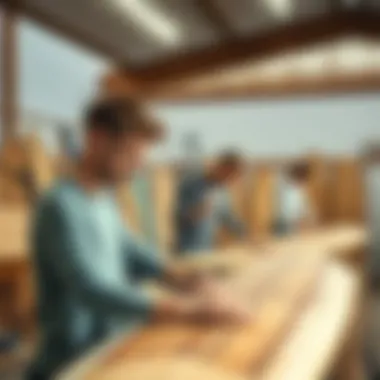
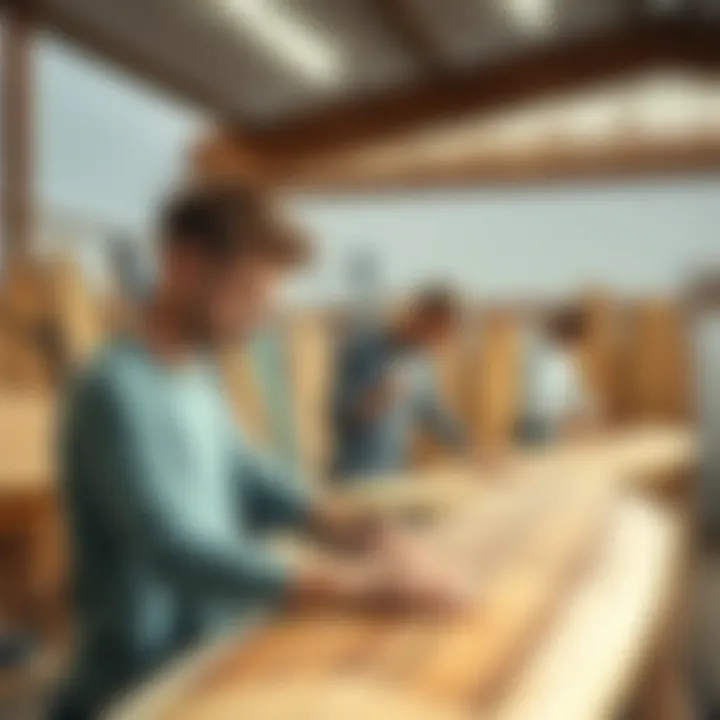
Epoxy resins stand as a prevalent choice among surfboard builders, mainly due to their impressive strength-to-weight ratio. Unlike traditional polyester resins, epoxy doesn't just form a solid laminate; it creates a robust bonding that generally withstands the rigors of ocean waves. One of the key characteristics of epoxy resins is their resistance to yellowing and UV damage, ensuring the looks of the board remain intact over time.
Epoxy boards are also less toxic during the manufacturing process, as they emit fewer volatile organic compounds. This quality makes them more appealing to environmentally conscious surfers. However, the initial cost of epoxy can be a bit steeper than other materials. Still, many prefer to invest in epoxy for the long-term durability it offers.
Polyurethane Foams
On the flip side, polyurethane foams have been the long-standing traditional choice in surfboard making. These materials are light, versatile and relatively inexpensive, which is why many beginners lean toward them initially. Their ease of shaping is another attractive feature; the foam responds well to various tools, allowing for finesse and personalization.
However, polyurethane is not without its pitfalls. It tends to absorb water if damaged, which can lead to rot and decomposition over time. New builders should keep in mind that while polyurethane boards are easier to work with, they require ongoing care and more attention to detail to maintain their performance and lifespan.
Wooden Templates
Wooden templates serve as the blueprint for shaping surfboards, guiding the builder in achieving the desired contours and volumes. Made from various types of wood, these templates allow for precision when cutting and shaping foam boards. One of the main advantages of using wooden templates is the craftsmanship they promote. They encourage builders to engage with each shape more intimately, forming a deeper connection to the final product.
The use of wood, however, comes with its own set of challenges. Wooden templates may require higher maintenance, and any inaccuracies in their edges can translate directly into imperfections in the finished board. Still, for those who appreciate traditional methods, wooden templates are a favorite, blending nostalgia with skill.
Tools Required for Building Surfboards
Shaping Tools
Shaping tools are the bread and butter of surfboard building. Whether it’s a planer, a surform, or an electric sander, each tool plays a significant role in the crafting process. The right shaping tools ensure you can maneuver the foam with precision. A good knife, for instance, helps carve out contours, while an electric sander is useful for smoothing and fine-tuning the final shape. Having an assorted toolkit allows builders to create boards that align closely with personal surfing styles.
Sanding Equipment
It’s no secret that sanding is often the least glamorous part of surfboard construction, but it’s one of the most crucial—like the icing on a cake. Proper sanding equipment, like various grits of sandpaper or sanding blocks, contributes to a smooth finish. That smooth surface is essential, not just for aesthetics, but to ensure optimal water flow when the board is in action. Generally, investing in quality sanding equipment pays off as it affects both the appearance and the performance of the board.
Fin Installation Kits
Fin installation kits allow builders to secure fins that enhance the performance of the surfboard. The process requires precision; mistakes can lead to instability in the water. These kits often include tools for drilling, sealing, and screwing in the fins securely. A well-installed fin is comparable to a strong foundation in a house—it’s essential. While they may add complexity to the building process, these kits provide flexibility in terms of fin types, allowing for customization that aligns with personal preferences.
In summary, grasping the foundations of surfboard construction equips builders with the capability to create their own unique surfboards, marrying their individual style with practical performance.
A nuanced approach to both materials and tools creates an engaging environment for builders, empowering them to take ownership of their creations and revel in the surfing experience that quality boards can provide.
What to Expect from a Surfboard Building Class
When diving into the world of surfboard building classes, it’s vital to understand what these courses offer. They are not just about craftsmanship; they bring together the essence of design, artistry, and personal connection to surfing. Having a clear picture of what to expect brings a world of advantages, not just in terms of skills learned but also in terms of community engagement and personal growth.
Curriculum Overview
The backbone of any surfboard building class is its curriculum. Each aspect is crafted to build knowledge and skill, ensuring that participants leave the experience not just as builders but as informed creators.
Preface to Theory and Design
The Introduction to Theory and Design segment is crucial. It lays out the foundational concepts that every budding surfboard builder should grasp. This isn’t merely a lecture; it’s a dive into the why and how of surfboard shaping. Participants learn about hydrodynamics, balance, and how the board's design can impact performance. The key characteristic here is its emphasis on understanding the principles behind the craft.
One of the unique features of this theory class is how it integrates interactive discussions and projects, allowing students to visualize their designs before embarking on practical applications. While some might find this segment less hands-on, it provides a critical viewpoint that many might overlook. It’s a reminder that before one wets the foam, understanding the science is foundational.
Hands-On Construction Techniques
Next up is Hands-On Construction Techniques. This part of the class is where the magic happens. Participants get to wield tools, shape foams, and see their ideas come to life. It's engaging and incredibly satisfying to feel the board under your hands. The hands-on aspect is one of the most lauded features; it’s direct and immediate, with instant gratification.
Each technique taught serves as a building block, be it shaping the outline or installing fins. The immediate feedback from instructors during these exercises is invaluable, as they share tips gathered from years of experience. However, it’s not without challenges; for some, the physicality may take a bit of getting used to, but that’s part of the learning curve.
Finishing Touches and Quality Check
After all the shaping, we have Finishing Touches and Quality Check. This section emphasizes the importance of detail. It’s about ensuring that every groove, every last coat of resin is perfect before taking the board to the waves. This part focuses on polishing your work and cementing the quality of what you’ve created.
A unique aspect of this part is the eye for detail trained within participants. Students learn not just to finish well, but to check their quality with a critical eye. Although some may find the final touches tedious, this creates an appreciation for craftsmanship that will reflect in their future creations.
"The satisfaction of seeing your work polished and ready is unmatched. It’s about taking pride in what you’ve made."
Instructor Qualifications and Experience
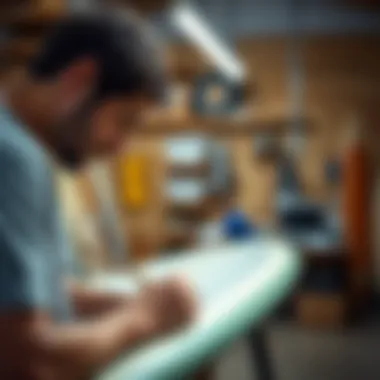
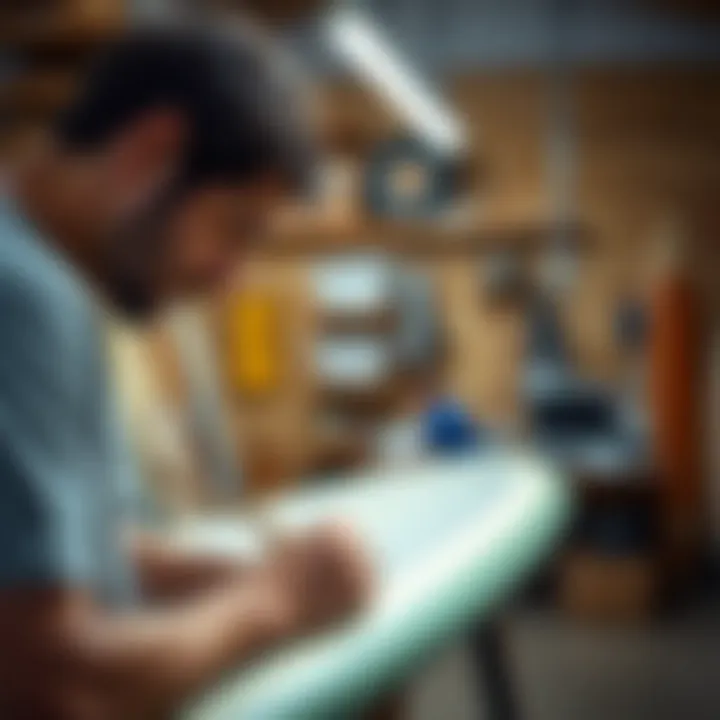
Moving onto the educators, the qualifications and experience of instructors can significantly influence the quality of the learning experience. These instructors bring a wealth of knowledge—many having spent years, if not decades, mastering the craft. Their backgrounds often include both practical experience on the waves and formal education in design or engineering. Some may even have experience running their own surfboard companies.
Having instructors with such diverse backgrounds not only enhances the credibility of the knowledge shared but also sparks rich discussions. When surfboard building merges with personal stories and experiences, it cultivates an environment ripe for creativity and inspiration. Participants often leave with more than just technical skills; they build relationships, gaining insights that books can’t teach.
In summary, this segment on expectations serves to guide potential participants, ensuring they have reasonable ideas about the content, benefits, and the caliber of teaching they’ll encounter. Whether you’re a seasoned surfer looking to dive deeper into craftsmanship, or a complete beginner, understanding these elements can set the stage for a transformative experience.
Finding the Right Surfboard Building Class
Finding the right surfboard building class is a pivotal step for anyone looking to immerse themselves in the art of surfboard crafting. It’s not just about attending a class; it’s about striking a balance between your learning style, the curriculum offered, and the community dynamics. This journey starts with understanding what you want out of this experience. Are you seeking a hands-on approach that builds physical skills? Or are you more intrigued by theoretical knowledge that delves into the history and technology behind surfboard design?
When searching for the right class, consider elements such as location, schedule flexibility, and class size. A smaller class can offer more personalized attention, which can be invaluable for beginners trying to grasp the nuances of surfboard building. Moreover, don’t underestimate the role of community; joining a class can lead to connections with fellow surf enthusiasts, enhancing your overall learning journey.
Local Workshops and Community Colleges
Local workshops and community colleges often serve as gateways for budding surfboard builders. These venues frequently offer affordable classes that allow you to work directly with instructors who have practical experience in shaping and finishing boards. Plus, there’s something special about working in a shared space, where you can chat with fellow participants about techniques and surf trips.
Community colleges also typically feature a diverse array of courses, catering to different skill levels. You might start with the basics and gradually work your way up to advanced shaping techniques. The instructors, often passionate surfers themselves, can share an insider’s perspective on balancing craftsmanship with the demands of surf culture.
Online Courses and Resources
Online resources offer an alternative for those who may not have access to local classes or for those who prefer learning at their own pace. The flexibility and variety found in online offerings can be major advantages.
Virtual Workshops
Virtual workshops stand out as a modern approach to surfboard building education. In these setups, participants can join live sessions from anywhere, connecting with seasoned instructors via video calls and interactive platforms. The beauty of virtual workshops lies in their accessibility. You could find an expert based thousands of miles away who specializes in a technique that piques your interest. Moreover, these workshops cater to various time zones, allowing you to fit learning into your busy schedule.
However, one downside might be the lack of hands-on experience; this often necessitates additional practice sessions in your own time. It’s vital to ensure that the virtual workshop you choose includes a solid plan for practical work you can do on your own.
YouTube Tutorials
YouTube tutorials are an ever-expanding library of free resources that surfboard builders can utilize. These videos bring a plethora of expertise right into your living room, letting you pause and rewind whenever you need clarity. The unique feature of YouTube is the capability for immediate feedback from the community; comments can spark discussions that enhance learning.
Despite their accessibility, these tutorials do come with some caveats. The quality and depth of content can vary widely, leading to misinformation if one is not careful. Therefore, it’s wise to cross-reference and verify techniques presented in various videos against trusted sources or established instructors.
"A good craftsman is not someone who simply follows a plan; they actively engage with the material, adapting and learning as they go along."
In summary, whether you choose a local workshop or an online course, the key is to align your choice with your personal learning goals and lifestyle. Each option offers unique advantages and challenges; the perfect fit will depend on what resonates with you.
Benefits of Taking Surfboard Building Classes
When it comes to surfboard building classes, the advantages extend far beyond just the act of constructing a board. These classes play a significant role in enhancing one’s surfing journey. They cultivate not only skills and knowledge but also community connections and a deeper appreciation for the art of surfing. Let's dive into the key benefits.
Enhancing Surfing Skills Through Customization
One of the most profound benefits of taking surfboard building classes lies in the customization aspect. When you build your own surfboard, you gain intimate knowledge of how different elements affect performance. The class enables surfers to comprehend aspects like rocker, volume, and tail shape, all pivotal for tailoring the board to personal style and preference.
By learning to customize, surfers can cater their boards to specific wave conditions or personal riding styles. For instance, a beginner might prefer a wider, more stable board for paddling ease and balance, while an advanced surfer might go for a thinner, performance-tailored board. Such knowledge might take years of trial and error on the water, but a solid building class can fast-track this learning curve.
Moreover, the ability to adjust the board's dimensions and features makes it a personal project, turning it from a mere tool into an extension of oneself on the waves. As the saying goes, "You ride the board, but it also rides you."
The Community Aspect of Surfboard Building
Surfboard building is not just about the craftsmanship; it’s also about the connections formed during the process. These classes often foster tight-knit communities among participants. Learning alongside fellow enthusiasts creates bonds that extend beyond just an instructional environment. These relationships can lead to lifelong friendships, which is invaluable for any surfer.
Sharing a passion for surfing and crafting boards promotes collaboration and idea exchange. Instructors who lead these classes often bring their own insights and experiences, enriching discussions and sparking inspiration. Moreover, working together on projects, whether it’s discussing the latest surf spots or troubleshooting a tricky shaping technique, enhances the sense of belonging among surfboard builders.
Through these community ties, surfers find support and motivation, which not only aids in the building process but also enhances the enjoyment of the sport itself. Meeting like-minded individuals can even lead to local surf groups or clubs, further enriching one’s surfing experience.
"Building surfboards is not just a task; it’s a journey shared with fellow adventurers of the waves."
In summary, taking surfboard building classes offers surfers a unique opportunity to enhance their skills while cultivating a sense of community. The blend of artistry and fraternity in these classes creates not just better surfboards but better surfers, aligning passion, creation, and shared experiences into something profoundly meaningful.
Challenges in Surfboard Construction
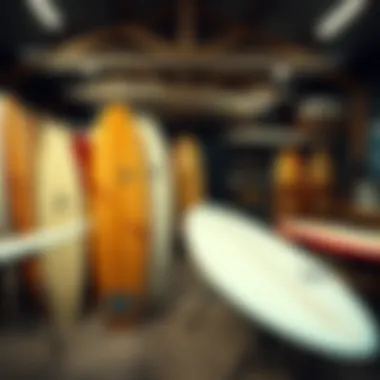
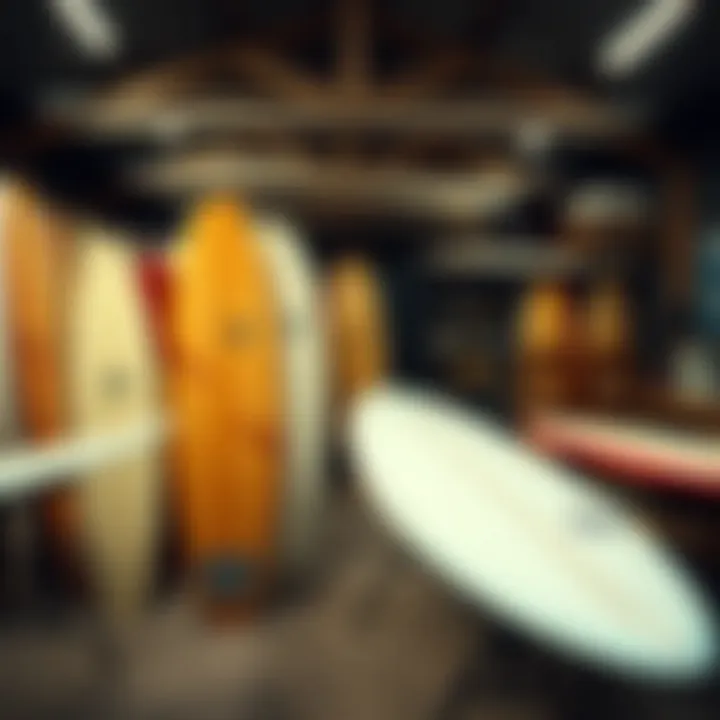
The journey of crafting a surfboard is not without its hurdles. As exhilarating as the prospect may be, aspiring builders often discover that challenges in surfboard construction can feel like towering waves. Understanding these challenges is essential not just for developing skill but also for fostering a deeper connection to the art of surfboard making. No one can glide through the process on a smooth ride, and knowing the common obstacles is half the battle.
Technical Issues Encountered by Beginners
For those stepping into the world of surfboard construction, technical issues can seem overwhelming. Perhaps the most frequent bump in the road revolves around shaping the board correctly. Many fresh faces in the craft find it difficult to achieve the desired outlines and contours. This often comes down to understanding the dynamics of pressure and angle when using shaping tools. A slip of the hand or a misguided measurement can easily set a novice back.
Moreover, achieving a smooth finish is another technical hurdle. Beginners often misuse sanders, leading to uneven surfaces or, worse still, gouges that require additional work to remedy. Knowing how to balance pressure, choose the right grit, and work methodically can pave smoother paths and swifter results.
"Surfboard building is like learning to surf itself. You face wipeouts, but with persistence, you find your flow."
An important aspect newcomers overlook is the adhesive and resin application. Too often, they underestimate the complexities involved, resulting in resin that doesn’t cure properly or that bubbles under the surface. Familiarizing themselves with the chemical properties and application techniques can save many headaches down the line.
Common Mistakes and How to Avoid Them
Just as a surfer learns from wiping out, a beginner in surfboard building can learn from common mistakes that often derail their progress. One prevalent mistake is the lack of a precise plan. Skipping this crucial step can lead to wasted materials and time. A clear sketch or blueprint serves as a roadmap, providing direction as the pieces come together.
Another common pitfall is neglecting safety gear. Resin fumes can be hazardous, and without proper ventilation and personal protective equipment, builders might end up with more than just a sore back. Wearing masks, goggles, and gloves should be non-negotiable. Safety might not feel like part of the craft when enthusiasm runs high, but it’s a foundational consideration.
Moreover, impatience can also rear its head. Rushing through the curing times or the sanding process often leads to subpar results. Allowing time for processes like drying and setting might feel tedious, but it pays off in the quality of the finished product.
To avoid pitfalls, embracing a mindset of learning and patience is vital. Joining communities or forums like Reddit can provide support, tips, and shared experiences that light the way for beginners. Sharing frustrations and successes with peers adds to the body of knowledge, creating a richer tapestry of surfboard building expertise.
In sum, navigating the challenges within surfboard construction requires a well-rounded approach. Emphasizing understanding, planning, and insight allows individuals to rise above the common hurdles and truly savor the art of shaping boards.
Testimonials from Participants
Hearing firsthand accounts from participants in surfboard building classes provides a unique lens into the experience that mere descriptions cannot capture. These testimonials often illustrate both the emotional and practical value of such classes. Participants reveal not just the skills they acquired, but the community bonds formed, and the renewed passion for surfing they discovered through the craft of board-making.
Sharing these real stories serves to inspire prospective students. It also highlights how these classes cultivate confidence, allowing individuals to express themselves creatively. Each testimony lays the groundwork for understanding the depth of engagement in surfboard building, showcasing the real-life transformation that can occur,
Experiences Shared by Previous Students
Previous students often recount how their initial curiosity about surfboards evolved into a genuine love for the craft. Many have noted that what began as a desire to customize their own boards evolved into a broader appreciation for the art form.
For instance, a student named Jake described his experience:
"Taking that class was like unlocking a new level in my surfing journey. I didn’t just learn to build a board; I discovered how much thought goes into each shape and curve. It felt like I was creating an extension of myself."
Such experiences underscore a pivotal benefit of these classes—the ability to personalize and innovate on traditional designs. Many also express a sense of accomplishment when they complete their projects; one graduate recalled:
- "When I caught my first wave on the board I built, it was pure magic."
These accounts reflect a deeper understanding surfaces among participants of what it truly means to surf—acknowledging the connection between rider and board.
Professional Insights from Instructors
Instructors offer invaluable perspectives on the overall journey of participants. Their insights often reveal patterns in the development of students, highlighting common challenges and triumphs. An experienced instructor might share:
"I see transformations every course. Students arrive with excitement and maybe some anxiety, but as they engage with the materials and sculpt their boards, that hesitation melts away. Building a surfboard turns into building one’s self-confidence."
Instructors also emphasize the importance of mentorship in these classes. They aim to guide participants not only in technical skills but also in fostering an environment where creativity thrives. They often describe how collaborative projects can enhance learning; a comment from an instructor captures this:
- "The beauty of surfboard building is that it fosters community. Participants help each other out, share ideas, and even challenge each other’s methods. It’s all about growth—together."
The insights from instructors reinforce the idea that surfboard building classes are not just about learning a skill; they're about nurturing a lifelong love for crafting and surfing. As they gather stories from various classes, these professionals serve as the bridge connecting the art of surfboard making back to the core thrill of riding the waves.
Ending
Wrapping up our exploration of surfboard building classes, it becomes clear that these educational experiences serve as more than just workshops. They’re critical for cultivating a deeper connection between surfers and their craft. As we’ve discussed throughout the article, these classes offer both practical skills and foster a sense of community that bolsters the surfing culture.
The Future of Surfboard Building Classes
Looking ahead, the future of surfboard building classes appears promising. With advancements in technology, we see emerging trends in materials and tools that can revolutionize how surfboards are constructed. For instance, eco-friendly materials are becoming more commonplace, making it easier for builders to reduce their environmental impact. Classes are likely to incorporate these innovations, helping future enthusiasts evolve their skills while remaining conscious of sustainability. Innovations in digital design software are another aspect that can be integrated into these classes, allowing beginners to visualize their creations before they even touch the raw materials.
Moreover, as the surfing demographic expands globally, we may witness a slew of newly designed courses tailored to diverse cultural practices surrounding surfing. This means that surfboard building will not just be a skill but a celebration of varying heritages and styles embraced worldwide. This diversification can enhance the overall surf culture, promoting knowledge-sharing and appreciation among different communities.
Encouraging a New Wave of Surfing Enthusiasts
Instilling enthusiasm in new surfers is vital for the longevity of surfing communities. Surfboard building classes are an ideal starting point. By educating future layers of surf culture, these classes empower individuals with the knowledge to customize boards that reflect their personality and preferences.
When students craft their own surfboards, they connect not just with the board but with the ocean itself, understanding the significance of each curve and fin placement. This connection leads to a generation that not only respects the ocean's power but also values sustainable practices and mindful surfing. Encouraging participation from youths, women, and diverse backgrounds can help dismantle stereotypes often associated with the sport, making it more inclusive.







